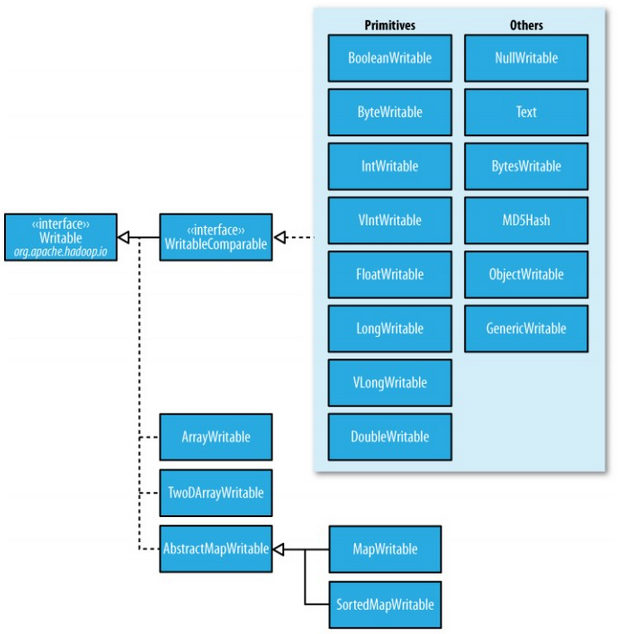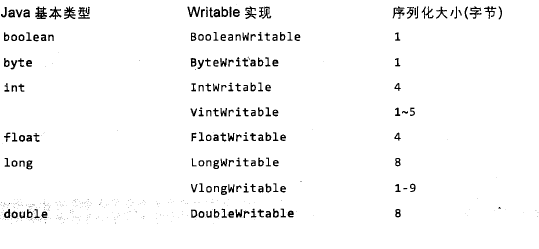Hadoop自带一套原子操作用于数据I/O。当中一些技术,如数据完整性保持和压缩,对于处理多达数个TB的数据时。特别值得关注。另外一些Hadoop工具或API。所形成的构建模块可用于开发分布式系统。比方序列化操作和on-disk数据结构。
本篇的内容主要有以下几点:
(1)通过检验和保证数据完整性
(2)Hadoop压缩
(3)Hadoop序列化-Writable
(4)Hadoop顺序文件-即文件序列化
数据完整性
(1)在数据的流转过中,HDFS通过“校验和”。来检验数据完整性,假设发现损坏,则新建一个replica,删除损坏的部分,是数据块的复本保持在期望的水平。
(2)datanode节点本身也会在一个后台线程中运行一个DataBlockScanner。从而定期验证本节点的全部数据块。
(3)Hadoop的LocalFileSystem运行client的校验和验证。在写入数据时。会新建一个名为.filename.crc的文件,用于校验
(4)假设底层文件系统本身已经有了校验机制,则能够使用一个不须要检验的文件系统RawLocalFileSystem:
Configuration conf = ...
FileSystem fs = new RawLocalFileSystem();
fs.initialize(null,conf);
(5)LocalFileSystem通过CheckSumFileSystem完毕校验操作,一般使用方法例如以下:
FileSystem rawFs = ...
FileSystem checksummedFs = new ChecksumFileSystem(rawFs);
Hadoop怎样使用压缩
压缩格式总结
gzip是比較通用的压缩格式,比較通用。bzip2比gzip更高效,但压缩速度慢一点。
bzip2解压比压缩快,但与其它压缩格式比,还是慢一点。LZO优化压缩速度,但效率略低。
DEFLATE是一个标准压缩算法。该算法的标准实现是zlib。没有可用于生产DEFLATE文件的经常使用命令行工具。由于通常都用gzip格式。
gzip格式仅仅是在DEFLATE格式添加了文件头和文件尾。
全部压缩算法都须要权衡时间和空间:一般来说-1为优化速度,-9为优化压缩空间,比如:gzip -1 file,代表最快压缩创建一个file.gz。
是否可切分。代表压缩算法是否支持切分(splitable)。即能否够搜索数据流任务位置并进一步往下读取数据。
可切分压缩尤其适合MapReduce。
codec
codec实现了一种压缩-解压算法。在Hadoop中,对接口CompressionCodec的实现代表一个codec,Hadoop实现的codec列表例如以下:
当中LZO代码库拥有GPL许可,不在Apache的发行版中。能够在http://github.com/kevinweil/hadoop-lzo下载。
(例程1)从标准输入读取数据,然后写入标准输出:
import java.io.FileInputStream;
import java.io.InputStream;
import org.apache.hadoop.conf.Configuration;
import org.apache.hadoop.io.IOUtils;
import org.apache.hadoop.io.compress.CompressionCodec;
import org.apache.hadoop.io.compress.CompressionOutputStream;
import org.apache.hadoop.util.ReflectionUtils;
public class StreamCompressor {
public static void main(String[] args) throws Exception {
String codeClassname = "org.apache.hadoop.io.compress.GzipCodec";
Class<?> codecClass = Class.forName(codeClassname);
Configuration conf = new Configuration();
CompressionCodec codec = (CompressionCodec) ReflectionUtils
.newInstance(codecClass, conf);
CompressionOutputStream out = codec.createOutputStream(System.out);
//InputStream in = new FileInputStream("/test/input/wc/file01.txt");
InputStream in = System.in;
IOUtils.copyBytes(in, out, 4096, false);
out.finish(); //这里仅仅是完毕到这个数据流的写操作。并没有关闭。所以能够接着往下流
}
}hadoop集群运行命令:echo "Text" | hadoop jar test.jar StreamCompressor | gunzip 。能够看到正确的输出。
(例程2)依据文件扩展名,利用工厂推断产生codec对文件进行解压缩:
import java.io.InputStream;
import java.io.OutputStream;
import java.net.URI;
import org.apache.hadoop.conf.Configuration;
import org.apache.hadoop.fs.FileSystem;
import org.apache.hadoop.fs.Path;
import org.apache.hadoop.io.IOUtils;
import org.apache.hadoop.io.compress.CompressionCodec;
import org.apache.hadoop.io.compress.CompressionCodecFactory;
public class FileDecompressor {
public static void main(String[] args) throws Exception {
String uri = "/test/input/t/1901.gz";
Configuration conf = new Configuration();
FileSystem fs = FileSystem.get(URI.create(uri), conf);
Path inputPath = new Path(uri);
CompressionCodecFactory factory = new CompressionCodecFactory(conf);
CompressionCodec codec = factory.getCodec(inputPath);
if (codec == null) {
System.err.println("No codec found for " + uri);
System.exit(1);
}
String outputUri = CompressionCodecFactory.removeSuffix(uri,
codec.getDefaultExtension());
InputStream in = null;
OutputStream out = null;
try {
in = codec.createInputStream(fs.open(inputPath));
out = fs.create(new Path(outputUri));
IOUtils.copyBytes(in, out, conf);
} finally {
IOUtils.closeStream(in);
IOUtils.closeStream(out);
}
}
}hadoop集群运行命令:
hadoop jar test.jar FileDecompressor。
hadoop fs -ls /test/input/t ,能够看到 /test/input/t/file01.gz 文件已经被解压了。
hadoop fs -cat /test/input/t/file01,能够查看文件内容。
(例程3)使用压缩池对标准输入的数据进行压缩,然后写入标准输出:
假设使用的是原生代码库。而且须要在应用中运行大量压缩和解压缩操作。能够考虑使用CodecPool,它同意你重复使用压缩和解压缩,以分摊创建这些对象所涉及的开销。
关于原生类库:
为了性能。最好使用原生(native)类库进行压缩和解压缩,比如。使用原生gzip类库能够降低大约一半的解压缩时间和10%的压缩时间(和内置的Java实现相比)。
并不是每种格式都有原生实现。例如以下表:
默认情况下。Hadoop会依据自身运行的平台搜索原生代码库,假设找到对应代码库就会自己主动载入。当然,特殊情况下,也能够禁用原生代码库,设置hadoop.native.lib为false(这确保使用内置的Java代码库,假设有的话)。
代码演示样例:
import java.io.InputStream;
import org.apache.hadoop.conf.Configuration;
import org.apache.hadoop.io.IOUtils;
import org.apache.hadoop.io.compress.CodecPool;
import org.apache.hadoop.io.compress.CompressionCodec;
import org.apache.hadoop.io.compress.CompressionOutputStream;
import org.apache.hadoop.io.compress.Compressor;
import org.apache.hadoop.util.ReflectionUtils;
public class PooledStreamCompressor {
public static void main(String[] args) throws Exception {
String codeClassname = "org.apache.hadoop.io.compress.GzipCodec";
Class<?> codecClass = Class.forName(codeClassname);
Configuration conf = new Configuration();
CompressionCodec codec = (CompressionCodec) ReflectionUtils
.newInstance(codecClass, conf);
Compressor compressor = null;
try {
compressor = CodecPool.getCompressor(codec);
CompressionOutputStream out = codec.createOutputStream(System.out,
compressor);
// InputStream in = new
// FileInputStream("/test/input/wc/file01.txt");
InputStream in = System.in;
IOUtils.copyBytes(in, out, 4096, false);
out.finish(); // 这里仅仅是完毕到这个数据流的写操作,并没有关闭,所以能够接着往下流
} finally {
CodecPool.returnCompressor(compressor);// 返回池子
}
}
}
(例程4)对查找最高气温的输出进行压缩:
import java.io.IOException;
import java.util.Iterator;
import org.apache.hadoop.fs.Path;
import org.apache.hadoop.io.IntWritable;
import org.apache.hadoop.io.LongWritable;
import org.apache.hadoop.io.Text;
import org.apache.hadoop.io.compress.CompressionCodec;
import org.apache.hadoop.io.compress.GzipCodec;
import org.apache.hadoop.mapred.FileInputFormat;
import org.apache.hadoop.mapred.FileOutputFormat;
import org.apache.hadoop.mapred.JobClient;
import org.apache.hadoop.mapred.JobConf;
import org.apache.hadoop.mapred.MapReduceBase;
import org.apache.hadoop.mapred.Mapper;
import org.apache.hadoop.mapred.OutputCollector;
import org.apache.hadoop.mapred.Reducer;
import org.apache.hadoop.mapred.Reporter;
public class MaxTemperatureWithCompression {
public static void main(String[] args) throws Exception {
JobConf conf = new JobConf(MaxTemperatureWithCompression.class);
conf.setJobName("Max Temperature With Compression");
// FileInputFormat.addInputPaths(conf, new Path(args[0]));
// FileOutputFormat.setOutputPath(conf, new Path(args[1]));
FileInputFormat.setInputPaths(conf, new Path("/test/input/t"));
FileOutputFormat.setOutputPath(conf, new Path("/test/output/t"));
// 设置压缩(输出gz压缩文件)
conf.setBoolean("mapred.output.compress", true);
conf.setClass("mapred.output.compression.codec", GzipCodec.class,
CompressionCodec.class);
conf.setMapperClass(MaxTemperatureWithCompressionMapper.class);
conf.setCombinerClass(MaxTemperatureWithCompressionReduce.class);
conf.setReducerClass(MaxTemperatureWithCompressionReduce.class);
conf.setOutputKeyClass(Text.class);
conf.setOutputValueClass(IntWritable.class);
JobClient.runJob(conf);
}
}
class MaxTemperatureWithCompressionMapper extends MapReduceBase implements
Mapper<LongWritable, Text, Text, IntWritable> {
private static final int MISSING = 9999;
public void map(LongWritable key, Text value,
OutputCollector<Text, IntWritable> output, Reporter reporter)
throws IOException {
String line = value.toString();
String year = line.substring(15, 19);
int airTemperature;
if (line.charAt(87) == '+') {
airTemperature = Integer.parseInt(line.substring(88, 92));
} else {
airTemperature = Integer.parseInt(line.substring(87, 92));
}
String quality = line.substring(92, 93);
if (airTemperature != MISSING && quality.matches("[01459]")) {
output.collect(new Text(year), new IntWritable(airTemperature));
}
}
}
class MaxTemperatureWithCompressionReduce extends MapReduceBase implements
Reducer<Text, IntWritable, Text, IntWritable> {
public void reduce(Text key, Iterator<IntWritable> values,
OutputCollector<Text, IntWritable> output, Reporter reporter)
throws IOException {
int maxValue = Integer.MIN_VALUE;
while (values.hasNext()) {
maxValue = Math.max(maxValue, values.next().get());
}
output.collect(key, new IntWritable(maxValue));
}
}查理结果:
hadoop fs -copyToLocal /test/output/t/part-00000.gz
gunzip -c part-00000.gz
应该使用哪种压缩格式
使用哪种压缩格式与详细应用相关。
是希望运行速度最快。还是更关注降低存储开销?通常,须要为应用尝试不同的策略,而且为应用构建一套測试标准,从而找到最理想的压缩格式。
对于巨大、没有存储边界的文件,如日志文件,能够考虑例如以下选项:
(1)存储未经压缩的文件
(2)使用支持切分的存储格式,如bzip2
(3)在应用中切分文件成块,然后压缩。这样的情况,须要合理选择数据库的大小,以确保压缩后数据近似HDFS块的大小
(4)使用顺序文件(Sequence File)。它支持压缩和切分
(5)使用一个Avro数据文件。改文件支持压缩和切分,就像顺序文件一样,但添加了很多编程语言都可读写的优势
对于大文件来说,不应该使用不支持切分整个文件的压缩格式,否则将失去数据的本地特性。进而造成MapReduce应用效率低下。
序列化(serialization)
序列化,是将结构化对象转换为字节流。以便传输或存储。反序列化。是指字节流转回结构化对象的逆过程。
序列化在分布式数据处理的两大领域经常出现:进程间通信和永久存储。
Hadoop使用自己的序列化格式Writable,它格式紧凑,速度快,但很难用Java以外的语言进行扩展或使用。由于Writable是Hadoop的核心,大多数MapReduce程序的键和值都会使用它。
Writable接口
Writable接口定义了两个方法:一个将其状态写到DataOutput二进制流,还有一个从DataInput二进制流读取状态,代码例如以下:
package org.apache.hadoop.io;
import java.io.DataOutput;
import java.io.DataInput;
import java.io.IOException;
public interface Writable {
void write(DataOutput output) throws IOException;
void readFields(DataInput in) throws IOException;
}Writable类
Hadoop自带的org.apache.hadoop.io包中有广泛的Writable类可供选择。
Writable类的层次结构例如以下图:
Java基本类型的Writable类:
实现定制的Writable类型
Hadoop本身已经有如上的Writable实现能够满足大部分要求,但有些时候。我们可能还是须要依据自己的需求构造一个新的实现。由于Writable是MapReduce数据IO的核心,所以调整成二进制表示能对性能产生显著效果。
例如以下演示存储一对Text对象的Writable类型:
import java.io.*;
import org.apache.hadoop.io.*;
public class TextPair implements WritableComparable<TextPair> {
private Text first;
private Text second;
public TextPair() {
set(new Text(), new Text());
}
public TextPair(Text first, Text second) {
set(first, second);
}
public void set(Text first, Text second) {
this.first = first;
this.second = second;
}
public Text getFirst() {
return first;
}
public Text getSecond() {
return second;
}
// @Override
public void write(DataOutput out) throws IOException {
first.write(out);
second.write(out);
}
// @Override
public void readFields(DataInput in) throws IOException {
first.readFields(in);
second.readFields(in);
}
@Override
public int hashCode() {
return first.hashCode() * 163 + second.hashCode();
}
@Override
public boolean equals(Object o) {
if (o instanceof TextPair) {
TextPair tp = (TextPair) o;
return first.equals(tp.first) && second.equals(tp.second);
}
return false;
}
@Override
public String toString() {
return first + " " + second;
}
// @Override
public int compareTo(TextPair tp) {
int cmp = first.compareTo(tp.first);
if (cmp != 0) {
return cmp;
}
return second.compareTo(tp.second);
}
}
例如以下演示在TextPair类的基础上,为了速度,实现一个RawComparator(上面的 TextPair是在对象的基础上比較,我们以下在序列化的字节流的基础上进行比較):
import java.io.IOException;
import org.apache.hadoop.io.Text;
import org.apache.hadoop.io.WritableComparator;
import org.apache.hadoop.io.WritableUtils;
public class Comparator extends WritableComparator {
private static final Text.Comparator TEXT_COMPARATOR = new Text.Comparator();
public Comparator() {
super(TextPair.class);
}
@Override
public int compare(byte[] b1, int s1, int l1, byte[] b2, int s2, int l2) {
try {
int firstL1 = WritableUtils.decodeVIntSize(b1[s1])
+ readVInt(b1, s1);
int firstL2 = WritableUtils.decodeVIntSize(b2[s2])
+ readVInt(b2, s2);
int cmp = TEXT_COMPARATOR.compare(b1, s1, firstL1, b2, s2, firstL2);
if (cmp != 0) {
return cmp;
}
return TEXT_COMPARATOR.compare(b1, s1 + firstL1, l1 - firstL1, b2,
s2 + firstL2, l2 - firstL2);
} catch (IOException e) {
throw new IllegalArgumentException(e);
}
}
static {
WritableComparator.define(TextPair.class, new Comparator());
}
}
为什么不用Java Object Serialization
Doug Cutting这样解释:“为什么開始设计Hadoop的时候我不用Java Serialization?由于它看起来太复杂,而我觉得须要有一个很精简的机制。能够用于精确控制对象的读和写。由于这个机制是Hadoop的核心。使用Java Serialization后,尽管能够获得一些控制权,但用起来很纠结。不用RMI也处于相似的考虑。高效、高性能的进程间通信是Hadoop的关键。
我觉得我们须要精确控制连接、延迟和缓冲的处理方式,然而RMI对此无能为力。
”
Doug觉得Java序列化不满足序列化的标准:精简、高速、可扩展、互操作。
精简:Writable不把类名写到数据流,它假设client知道会收到什么类型,结果是这个格式比Java序列化更加精简,同一时候支持 随机存取和訪问。由于流中的每一条记录均独立于其它记录。
高效:Writable对象能够(而且通常)重用。对于MapRe作业(主要对仅仅有几个类型的大量对象进行序列化和反序列化)。不须要为新建对象分配空间而得到的存储节省是很可观的。
Avro
Apache Avro是一个独立于编程语言的数据序列化框架。该项目是由Doug Cutting创建的。旨在解决Hadoop中Writable类型的不足:缺乏语言的可移植性。
本篇不介绍这个框架,能够參阅官方网址:http://avro.apache.org 。
顺序文件
顺序文件,即流式文件。二进制文件。Hadoop开发了一组对象,来处理顺序文件。
SequenceFile
(1)写入SequenceFile对象
import java.io.*;
import java.net.URI;
import org.apache.hadoop.conf.Configuration;
import org.apache.hadoop.fs.*;
import org.apache.hadoop.io.*;
public class SequenceFileWriteDemo {
private static final String[] DATA = { "One,two", "Threw,four", "Five,six",
"Seven,eitht", "Nine,ten" };
public static void main(String[] args) throws IOException {
String uri = "/test/numbers.seq";
Configuration conf = new Configuration();
FileSystem fs = FileSystem.get(URI.create(uri), conf);
Path path = new Path(uri);
IntWritable key = new IntWritable();
Text value = new Text();
SequenceFile.Writer writer = null;
try {
writer = SequenceFile.createWriter(fs, conf, path, key.getClass(),
value.getClass());
for (int i = 0; i < 100; i++) {
key.set(100 - i);
value.set(DATA[i % DATA.length]);
System.out.printf("[%s] %s %s
", writer.getLength(), key,
value);
writer.append(key, value);
}
} finally {
IOUtils.closeStream(writer);
}
}
}
writer.getLength()实际取出的是流式文件的偏移量,是记录的边界。
(2)读取SequenceFile
import java.io.*;
import java.net.URI;
import org.apache.hadoop.conf.Configuration;
import org.apache.hadoop.fs.*;
import org.apache.hadoop.io.*;
import org.apache.hadoop.util.ReflectionUtils;
public class SequenceFileReadDemo {
public static void main(String[] args) throws IOException {
String uri = "/test/numbers.seq";
Configuration conf = new Configuration();
FileSystem fs = FileSystem.get(URI.create(uri), conf);
Path path = new Path(uri);
SequenceFile.Reader reader = null;
try {
reader = new SequenceFile.Reader(fs, path, conf);
Writable key = (Writable) ReflectionUtils.newInstance(
reader.getKeyClass(), conf);
Writable value = (Writable) ReflectionUtils.newInstance(
reader.getValueClass(), conf);
long position = reader.getPosition();
while (reader.next(key, value)) {
String syncSeen = reader.syncSeen() ? "*" : "";// 同步点
System.out.printf("[%s%s] %s %s
", position, syncSeen, key,
value);
position = reader.getPosition();// beginning of next record
}
} finally {
IOUtils.closeStream(reader);
}
}
}
在顺序文件里能够搜索给定位置,有两种方法:第一种是reader.seek(359),假设359不是记录的边界的话。则reader.next(key,value)时,会报IOException;另外一种是reader.sync(360)。代表从360之后找第一个同步点。
同步点是指当数据读取的实例出错后,能够再一次与记录边界同步的数据流中的一个位置。
同步点是SequenceFile.Writer记录的,在顺序文件写入过程中,每隔一定记录便插入一个特殊项标记同步标注。
同步点始终位于记录的边界处。
(3)通过命令行接口显示及排序SequenceFile
hadoop fs -text 能够识别gzip压缩文件及顺序文件,其它格式,则觉得是文本文件。
hadoop fs -text /test/numbers.seq
MapFile
(1)写入MapFile
MapFile是已经排序的SequenceFile,而且已经添加用于搜索键的索引。
写入MapFile代码例如以下:
import java.io.*;
import java.net.URI;
import org.apache.hadoop.conf.Configuration;
import org.apache.hadoop.fs.*;
import org.apache.hadoop.io.*;
public class MapFileWriteDemo {
private static final String[] DATA = { "One,two", "Threw,four", "Five,six",
"Seven,eitht", "Nine,ten" };
public static void main(String[] args) throws IOException {
String uri = "/test/numbers.map";
Configuration conf = new Configuration();
FileSystem fs = FileSystem.get(URI.create(uri), conf);
IntWritable key = new IntWritable();
Text value = new Text();
MapFile.Writer writer = null;
try {
writer = new MapFile.Writer(conf, fs, uri, key.getClass(), value.getClass());
for (int i = 0; i < 1024; i++) {
key.set(i+1);
value.set(DATA[i % DATA.length]);
writer.append(key, value);
}
} finally {
IOUtils.closeStream(writer);
}
}
}能够通过hadoop命令查看,发现生成了numbers.map目录。里面有data和index文件:
hadoop fs -text /test/numbers.map/data | head
hadoop fs -text /test/numbers.map/index | head
关于index文件。默认情况下。是每隔128个键才有一个,能够通过MapFile.Writer实例中的setIndexInterval()方法设置io.map.index.interval属性。添加间隔数量能够有效降低用于存储索引的内存,减小间隔数量。能够提高随机訪问的时间。




